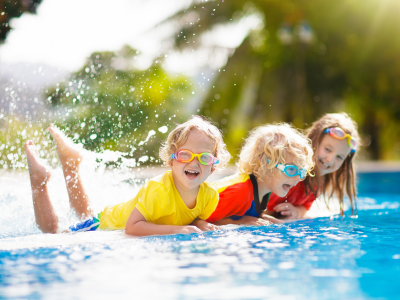Having a backyard pool is a dream for many families. It’s a place to relax, have fun, and create memories. But if you have kids or pets at home, your fun should always come with a layer of safety. A curious toddler or a playful pup can easily get into danger around the water. That is why it is crucial to prioritize pool safety for children and pets.
The good news is, making your pool safer does not mean taking the fun away. With just a few smart changes, you can feel more confident while your family enjoys the water. Every pool owner should know a few simple safety steps to help protect both kids and pets.
Why Pool Safety Should Be Your Top Priority
Drowning is one of the leading causes of accidental death in young children. And while we often think about kids first, many people do not realize that pets are at risk, too. Dogs can fall into the pool and struggle to get out. Even cats, who are usually more cautious, can slip and panic in the water. Accidents can occur in seconds, and without the proper safety measures, the consequences can be devastating.
Aside from the emotional toll, there is also a legal side. If someone else’s child or pet gets injured in your pool, you could be held responsible. That is why it’s not just about having fun. It is about doing what is right for everyone who steps into your yard, on two legs or four.
Install Physical Barriers Around Your Pool
The first and most important step is keeping unsupervised access to the pool to a minimum. A proper fence can stop both kids and pets from wandering into danger.
In fact, the U.S. Consumer Product Safety Commission reports that installing proper pool fencing can reduce a child’s risk of drowning by 83%, a powerful reason to make this your first safety upgrade.
- Choose a fence that is at least four feet high.
- Ensure it features a self-latching, self-closing gate.
- Avoid wide gaps that small children or small pets could slip through.
You can also consider pool covers. But not just any cover, make sure it is a safety-rated one that can support weight and lock in place. Pets and kids can fall onto weak covers and become trapped underneath. For extra protection, install alarms on gates and doors that lead to the pool area. Some alarms can even detect movement in the water.
Be Present and Aware at All Times
No amount of equipment can replace supervision. Accidents often happen when adults are distracted, looking at phones, chatting, or stepping inside “just for a minute.” If kids are in or near the pool, always have an adult assigned as the “water watcher.” This person should not be doing anything else. Their job is to monitor and remain vigilant.
The same applies to pets. If your dog likes to run around the yard, make sure someone is watching when they are near the water. Even good swimmers can get tired or panic if they can’t find a way out.
Teach Kids the Basics of Water Safety

One of the most effective ways to protect children is to teach them how to swim. Formal lessons can start as early as age one, depending on the child. Make sure they learn how to:
- Float and tread water
- Get in and out of the pool safely.
- Recognize when it’s time to call for help.
Also, set clear rules and repeat them often:
- No running near the pool
- No swimming without an adult
- No pushing or rough play
Keep flotation devices handy, but don’t rely solely on them. And every parent or caregiver should know CPR. In an emergency, those first few minutes are critical.
Do not forget Pet Safety
Just like you train kids, you should also guide your pets around the pool. Start by showing them how to enter and exit safely. You can even buy a pet ramp designed to help them climb out easily. If they fall in and can’t find the steps, panic can set in quickly.
Not all dogs are natural swimmers. Breeds with short legs or heavy bodies (like bulldogs) may struggle in the water. Even if your dog loves swimming, do not assume they are always safe. Keep an eye on them just like you would a toddler.
Also, discourage your pets from drinking pool water. Too much chlorine, or salt, in the case of saltwater pools, can upset their stomachs or cause other health problems. Always provide a bowl of fresh water nearby.
Store Chemicals Safely and Test the Water Regularly
Pool chemicals are essential for maintaining clean water, but they can also be hazardous if misused. Always store them in a secure location, out of the reach of children and pets. Keep containers sealed and off the ground if possible.
Also, test your pool water regularly. Chlorine levels that are too high can irritate eyes and skin, not just for kids, but also for your furry friends. Some pets may experience allergic reactions or develop rashes due to poor water balance.
Maintain safe levels of chlorine and pH. This helps avoid problems and keeps everyone comfortable during swim time.
Have Emergency Gear Ready and Visible
You do not want to be searching for a life ring during an emergency. Keep safety equipment, such as a first aid kit, near the pool at all times. Here are a few must-haves:
- Life ring or reaching pole
- First aid kit
- Phone or waterproof emergency call device
- CPR instructions posted nearby
Quick access can save lives; it’s that simple. Also, remember to inspect your equipment regularly to ensure everything is in working order.
Think About Off-Season Safety Too
When the pool is not in use, it still needs to be secure. Winter covers can sag under weight, posing a serious danger to both children and pets. Use tight, locked safety covers and double-check that gates are always closed.
If you drain your pool for the season, remove any standing water that can collect in low spots or on the cover. Even a few inches of water can pose a risk to small children or animals.
Make Safety a Habit, Not Just a Checklist
The best way to keep your pool safe is not just about equipment or rules; it is about routine. Make safety part of your daily habits during the warmer months. Set reminders to check gates, test the water, or review pool rules with the kids.
If you have regular guests, discuss your pool safety rules with their parents. The more open and transparent you are, the better protected everyone will be. Also, be sure to share the rules with pet sitters, babysitters, or anyone else who may be around your pool.
A Safer Pool Starts With You
Your pool can be a source of joy and relaxation, but only if it’s also a place of safety. With the proper setup and habits, you can protect your kids, your pets, and yourself from unexpected accidents. Even small changes, such as installing a gate or practicing swimming with your dog, can make a significant difference.
Pool safety for kids and pool safety for pets are not just one-time tasks. It’s something that takes constant attention. But the reward is worth it: fewer worries, happy memories, and a pool that is safe for everyone in the family.
At BC Pools, we recognize the importance of pool safety to families. We’re here to support homeowners across Northwest Arkansas with smart, practical solutions that help keep your pool safe and enjoyable for everyone.
Frequently Asked Questions
1. How can I make my pool safe for children?
Install a fence at least four feet high with a self-latching gate. Use a safety pool cover and add alarms on doors or gates. Always supervise children and teach them basic pool safety rules.
2. Are pets in danger around backyard pools?
Yes. Pets can fall in and panic, especially if they can’t find the steps. Supervise them, show them where the exit is, and consider adding a pet ramp for easy access.
3. How do I keep the pool safe when no one is using it?
Use a locked safety cover and keep all gates closed at all times. Install alarms on doors and around the pool area to alert you if anyone enters without supervision.
4. Is pool water harmful to pets?
Drinking pool water can upset a pet’s stomach. Excessive chlorine or salt can also cause skin issues. Keep clean water nearby and check chemical levels regularly.
5. What safety equipment should be near the pool?
Keep a life ring, a reaching pole, a first aid kit, a phone or call device, and CPR instructions near the pool. These help during emergencies and improve pool safety for kids and pets.


